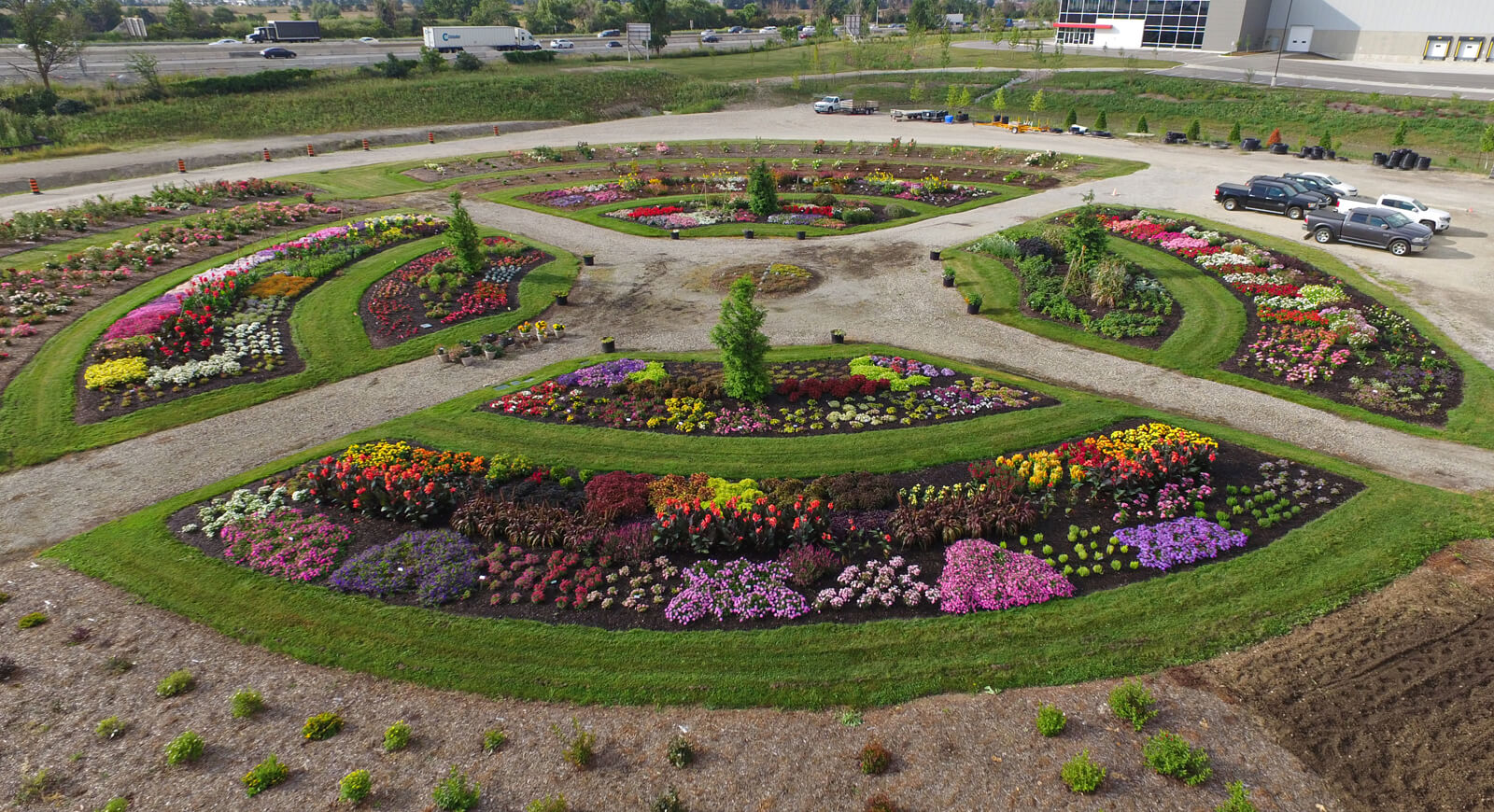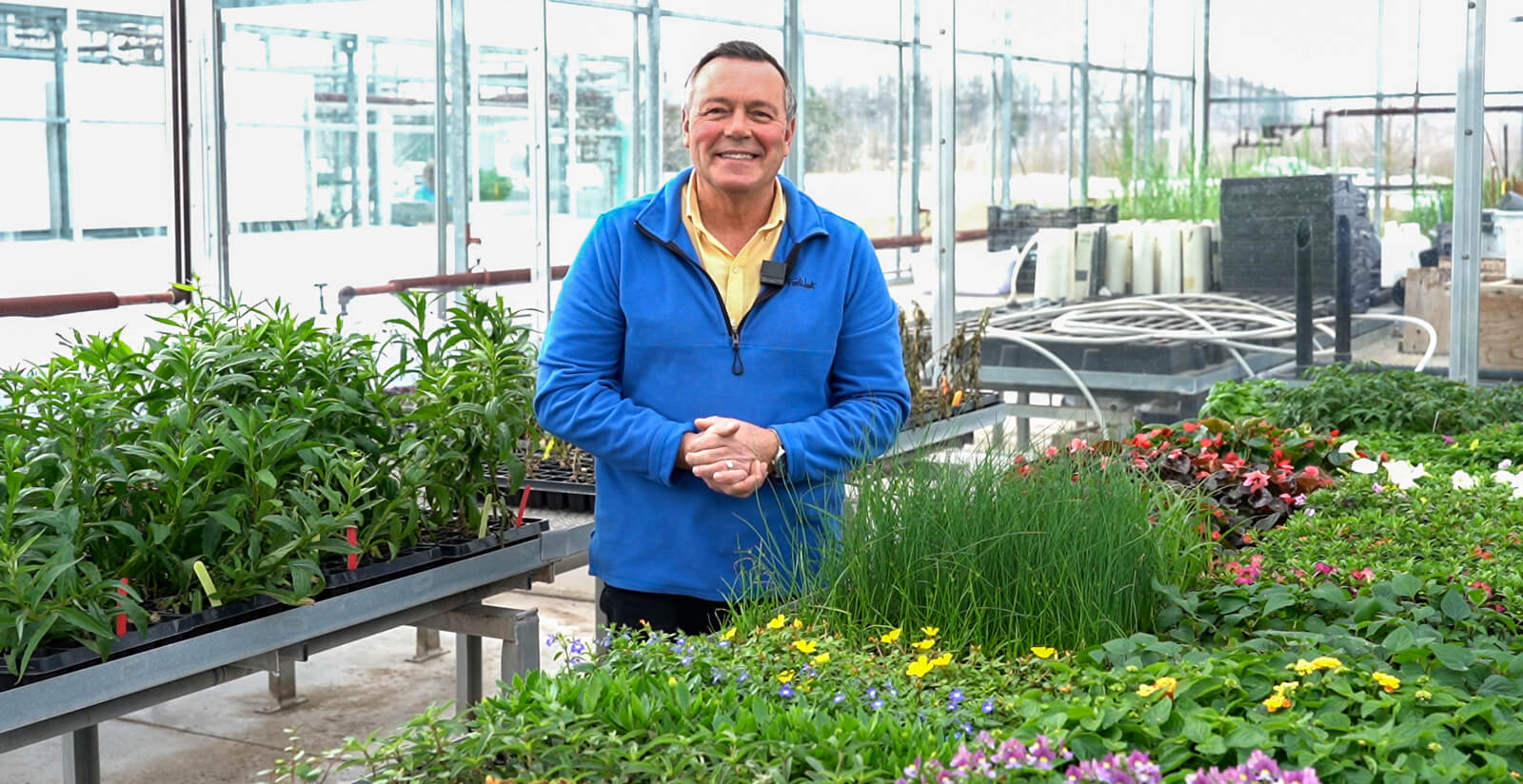May 31, 2022

2022 Trial Gardens
The plant selection you see at the garden centre has had quite the rigorous journey before it ends up on the market. As you browse for ornamental annuals and perennials, grasses, shrubs, and trees, you might be interested to know how the different varieties and cultivars have been tested for hardiness, growth rate, resilience to pests, tolerance of soil and light conditions, and other factors. They’ve also been compared to similar plants for colour, texture, size, and uniqueness.
Trial gardens put plants in various growth conditions where horticulture technicians and experienced growers can record and evaluate their performance. Landscape Ontario hosts one of these gardens; you might have noticed it when passing by on Highway 401 if you haven’t been lucky enough to visit it in person (you’re welcome to, by the way).
Our trial garden is managed by Rodger Tschanz from the University of Guelph. He also manages the trial gardens at the Bovey Greenhouses and Guelph Turfgrass Institute, as well as at the Royal Botanical Gardens in Burlington, Ont.
 Rodger Tschanz in the greenhouse.
Rodger Tschanz in the greenhouse.
Various breeders, such as Proven Winners, send Tschanz seeds or cuttings of plants they want trialed before taking them to market. Tschanz and his team of researchers apply different stresses to plants to mimic harsh conditions, such as drought or exposure to salt. They’ll try to evaluate why one plant might be prone to disease while another seems resistant. And as the trend for small-space balcony gardens increases, Tschanz is interested to see how perennials perform in containers as opposed to in the landscape. Homeowners, landscape designers, and garden enthusiasts can read the published report of the trial garden results in the fall.
Follow along to learn more about trial gardens and how they influence what goes in your landscape. In our 2022 Trial Garden video series, we’ll explore a full season of growth, from seeds to sensational standouts.
Trial garden manager Rodger Tschanz is interested in trialing perennials in containers in a wide variety of conditions. The Ontario perennial trial has about 200 entries and some of these would be particularly useful in a container study, including phlox, buddleia, penstamon, and various salvias.
Soil composition, drainage, temperature, and room for root growth are all important factors but something we all want to know is how well a plant can make it through a Canadian winter to bloom some hope in early spring.
Many types of overwintered perennials tend to blossom earlier than seeds started in the spring. They might also have larger blooms, grow taller, and be more resilient to pests and harsh weather. Results can vary, which is why trials are done in the first place.
At the trial garden, some of these perennials were well established at the end of the growing season. After cutting back the trial plants, they get put outside in their four-inch pots and covered in a blanket and a plastic tarp to protect them from frost, snow, and other wintery factors.
That doesn’t always stop the mice, though, who may also enjoy the protection from winter. So as the plants are uncovered each spring, they’re inspected for damage from tiny teeth. Those that look promising continue to be observed during the next growing season.
Trial gardens put plants in various growth conditions where horticulture technicians and experienced growers can record and evaluate their performance. Landscape Ontario hosts one of these gardens; you might have noticed it when passing by on Highway 401 if you haven’t been lucky enough to visit it in person (you’re welcome to, by the way).
Our trial garden is managed by Rodger Tschanz from the University of Guelph. He also manages the trial gardens at the Bovey Greenhouses and Guelph Turfgrass Institute, as well as at the Royal Botanical Gardens in Burlington, Ont.
 Rodger Tschanz in the greenhouse.
Rodger Tschanz in the greenhouse.
Various breeders, such as Proven Winners, send Tschanz seeds or cuttings of plants they want trialed before taking them to market. Tschanz and his team of researchers apply different stresses to plants to mimic harsh conditions, such as drought or exposure to salt. They’ll try to evaluate why one plant might be prone to disease while another seems resistant. And as the trend for small-space balcony gardens increases, Tschanz is interested to see how perennials perform in containers as opposed to in the landscape. Homeowners, landscape designers, and garden enthusiasts can read the published report of the trial garden results in the fall.
Follow along to learn more about trial gardens and how they influence what goes in your landscape. In our 2022 Trial Garden video series, we’ll explore a full season of growth, from seeds to sensational standouts.
What are the trial gardens?
Overwintered Perennials
At the end of each growing season, gardeners need to decide what to do with perennial plants over the winter. At the University of Guelph trial gardens, many of their successful perennials get put outside to make room for other plants in the hoop houses (unheated temporary structures).Trial garden manager Rodger Tschanz is interested in trialing perennials in containers in a wide variety of conditions. The Ontario perennial trial has about 200 entries and some of these would be particularly useful in a container study, including phlox, buddleia, penstamon, and various salvias.
Soil composition, drainage, temperature, and room for root growth are all important factors but something we all want to know is how well a plant can make it through a Canadian winter to bloom some hope in early spring.
Overwintering for an early spring start
Overwintering sometimes means starting seeds in the fall before day length drops to below 10 hours a day and before the first hard freeze occurs. This allows roots to establish and plants to acclimatize to less light and cold temperatures without spending energy on vegetative growth.Many types of overwintered perennials tend to blossom earlier than seeds started in the spring. They might also have larger blooms, grow taller, and be more resilient to pests and harsh weather. Results can vary, which is why trials are done in the first place.
At the trial garden, some of these perennials were well established at the end of the growing season. After cutting back the trial plants, they get put outside in their four-inch pots and covered in a blanket and a plastic tarp to protect them from frost, snow, and other wintery factors.
That doesn’t always stop the mice, though, who may also enjoy the protection from winter. So as the plants are uncovered each spring, they’re inspected for damage from tiny teeth. Those that look promising continue to be observed during the next growing season.
Videos
Introduction to the Trial Gardens.
Container verses landscape trials (less peat moss).
Taking cuttings for propagation research.
Trialling plants over the winter.
Growing plants from cuttings versus seeds.
Standing up to the rigours of winter.
Early May update.
Naming conventions and cultivars.
Weather concerns.
Lasting fall colour.
Wildflower container plants.